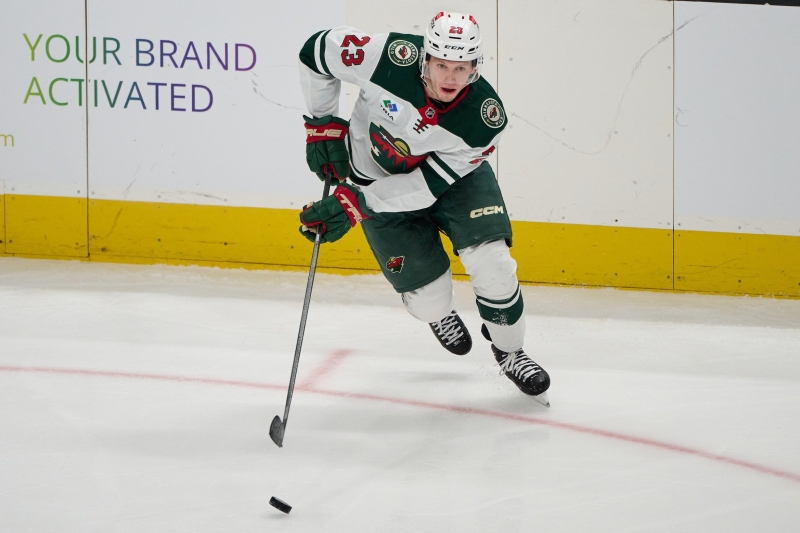In the end, all it took to bridge the seemingly unbridgable gap between the Minnesota Wild and Marco Rossi was… another bridge. After neither side made ground on a long-term deal, the two parties kicked the can down the road for three years, with a contract that will carry a $5 million cap hit.
Both sides get to save a bit of face here. Bill Guerin and the Wild secured the sort of low-cost “second contract” that’s rapidly becoming extinct in the NHL. Meanwhile, Rossi got the AAV the Wild initially wanted for a five-year deal, but without having to sell off any of his UFA years.
But for the short term, there’s not much doubt who gets the better end of the deal, and that’s the team. $5 million per season actually comes beneath the $5.26 million projection that Evolving-Hockey’s contract model estimated for a three-year term at the beginning of the offseason. Heck, just yesterday, the Chicago Blackhawks paid Frank Nazar III for seven years at a $6.60 million cap hit, and Nazar has just 27 career points!
Beyond the raw numbers and comparables, Rossi’s cap hit of $5 million, rather than, say, $7 million, has practical benefits for the Wild this season. They’ve now got their full 23-man roster locked in, with $4.41 million in cap space. As things stand, the Carolina Hurricanes and New Jersey Devils are the only teams that made the postseason last year that have more cap space than Minnesota.
After sitting on the sidelines at the trade deadline these past few years, the Wild are finally poised to make a splash. It’d still be possible to swing a big trade had Rossi made $7 million, but the Wild undeniably have more flexibility with him at a $5 million price point.
These short-term benefits make the “second contract” appealing to GMs like Guerin. To refresh your memory on the old economics of the NHL, the “second contract” was in its heyday during the first decade or so of the salary cap era. Teams had players under control coming off their entry-level contracts, and the threat of offer sheets was mild. So teams would give their star players a bump on a short-term deal that walked their big payday closer to free agency, giving the team some time to stagger the financial hit.
The “second contract” isn’t dead yet, but those are largely reserved for mid-tier players, not stars. For example, Alex Laferriere (19 goals, 42 points last season), got a three-year, $4.1 AAV deal earlier this month. But for star-caliber players, it’s almost gone, even in Minnesota. Kirill Kaprizov got his $9 million AAV after one season. Matt “49 Sheets” Boldy got his payday coming off his ELC, as did Brock Faber following his rookie season.
But in aggressively pursuing the “second contract” for Rossi, Guerin ignored one critical fact: The “second contract” kind of sucks for star players.
Teams don’t give these massive paydays out of the goodness of their hearts. They’re trying to get a deal. They’re buying high now, but in the long run, they believe that they’re paying a player as little as possible for as long as possible.
That’s why we’ve seen an explosion in cap hits for players who haven’t shown to be as good as Rossi. There is undeniably sticker shock when, say, Gabriel Vilardi gets a $7.5 million cap hit, or Matt Coronato gets $6.5 million, or Logan Stankoven gets $6 million. But as Rossi’s contract expires, the league salary cap will sit at $113.5 million. Over the long haul, those prices will become normal, and probably even bargains.
The same would likely have played out for Rossi. Had he gotten Boldy’s seven-year, $49 million deal, he would have made $7.3% of the salary cap for next season. By Year 3 of the contract, $7 million would already be just 6.1% of the cap, the equivalent of $5.9 million today. There’d be four more years of growth following that!
But now, at the end of those three years, there is going to be a payday for Rossi. Let’s assume that Rossi’s production stays relatively steady over that time, with no growth. He’s a 60-point center. That’s already worth about $7.7 million (8.1% of the 2025-26 cap) on the open market, according to Dom Luszczyszyn’s Player Cards.
Assuming the cap jumps $6.5 million in 2028-29 to the $120 million range, we can estimate that Rossi’s market value will be approximately $9.68 million. And that’s if the growth we’ve seen over the last two seasons levels off, or if the cap increases start to slow.
Had Minnesota opted to go long-term with Rossi, his price point would have remained at $7 million, which, under a $120 million cap hit, would be equivalent to around $5.6 million today. Remember, they’d have also bought three UFA years with that salary!
The Wild have gotten a lot of mileage out of their limited dollars, largely due to being proactive and securing key players on deals that age well. Underpaying Kaprizov, Boldy, and Joel Eriksson Ek made a team with $15 million of dead money a playoff squad last season. That’s the power of cheap deals, and Minnesota still has five years remaining of Boldy at $7 million, and four seasons of Eriksson Ek at $5.25 million.
Guerin had an opportunity to add Rossi to that collection of eventual bargains, but either prioritized maximizing flexibility for the next three seasons or didn’t believe in Rossi enough to bet on a windfall of future savings. It might look great for these next three seasons, but the bill is going to come due eventually, and the Wild might wish they’d have played the long game when 2028 rolls around.
